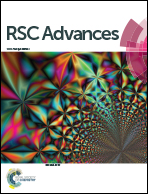A fluorescent sensor for Cu2+ and Fe3+ based on multiple mechanisms†
Abstract
A new fluorescent sensor for the selective and sensitive sensing of Cu2+ and Fe3+ based on the rational control of multiple mechanisms has been developed. Sensor L is weakly-fluorescent (ϕ = 0.029) due to the C![[double bond, length as m-dash]](https://www.rsc.org/images/entities/char_e001.gif) N isomerization and PET process. Upon binding with Cu2+, the complex L + Cu2+ can give a remarkable fluorescence enhancement (ϕ = 0.182) with a limit of detection down to 1.3 × 10−8 mol L−1 because of both inhibition of the C
N isomerization and PET process. Upon binding with Cu2+, the complex L + Cu2+ can give a remarkable fluorescence enhancement (ϕ = 0.182) with a limit of detection down to 1.3 × 10−8 mol L−1 because of both inhibition of the C![[double bond, length as m-dash]](https://www.rsc.org/images/entities/char_e001.gif) N isomerization and PET process. However, upon binding with Fe3+, the original weak fluorescence of L is completely quenched (ϕ = 0.002) due to the paramagnetic quenching property. In addition, the complex L + Cu2+ could be further used as a new platform for the ultrasensitive detection of Fe3+ based on the fluorescence “turn-off” response with a limit of detection down to 2.4 × 10−8 mol L−1 in aqueous solution.
N isomerization and PET process. However, upon binding with Fe3+, the original weak fluorescence of L is completely quenched (ϕ = 0.002) due to the paramagnetic quenching property. In addition, the complex L + Cu2+ could be further used as a new platform for the ultrasensitive detection of Fe3+ based on the fluorescence “turn-off” response with a limit of detection down to 2.4 × 10−8 mol L−1 in aqueous solution.


 Please wait while we load your content...
Please wait while we load your content...